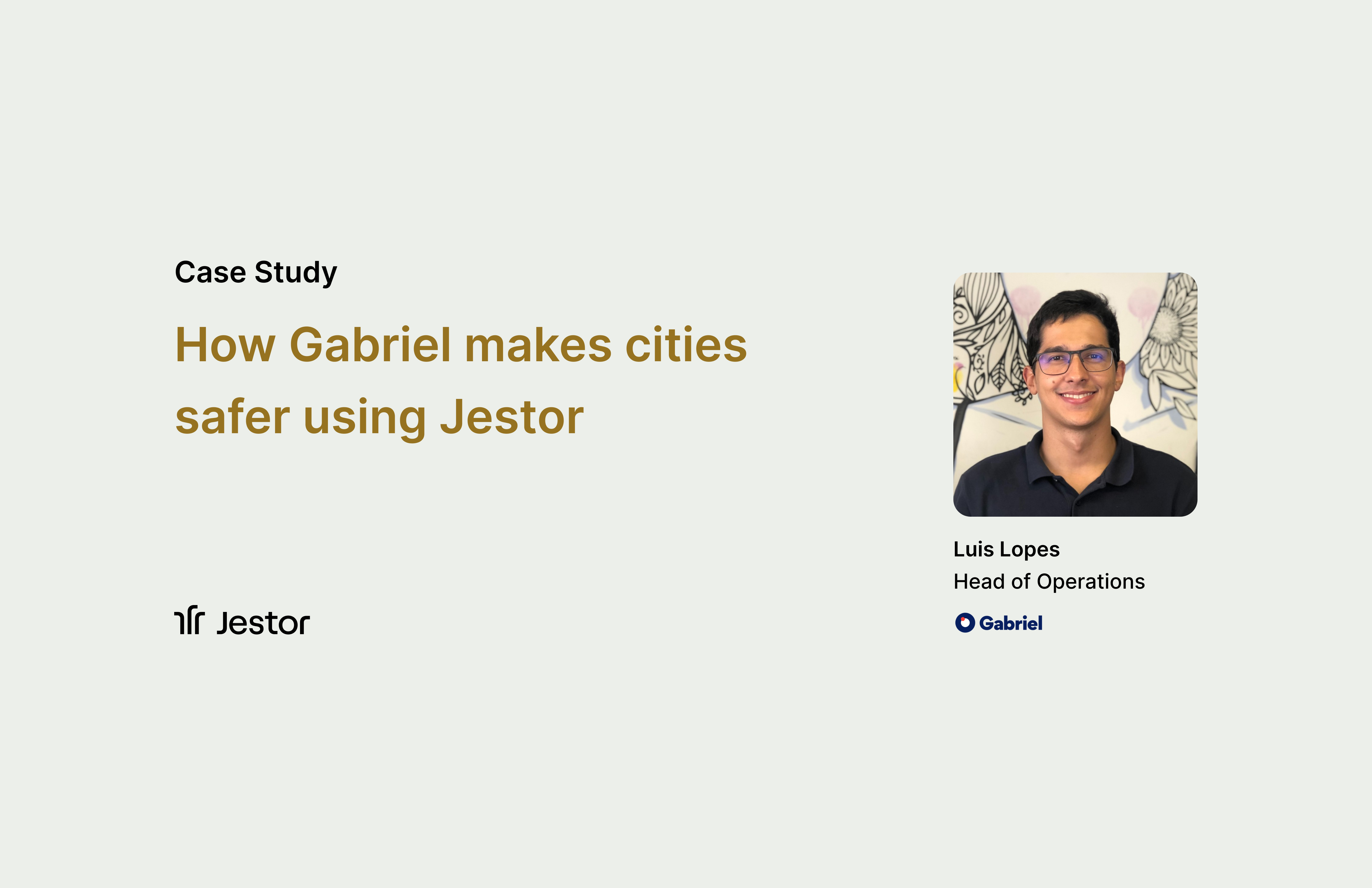How Gabriel makes cities safer using Jestor

While other productivity tools could fulfill some of their needs independently, Gabriel felt hampered by those tools’ inability to work together and having a single source of truth. Gabriel tapped into Jestor’s no-code and low-code potential to create the perfect tool for their ever expanding operation.
Numbers
Team efficiency
The same team is able to handle an operation 4x larger than before.
Safe scalability
There are currently 100+ team members operating Jestor, all with enterprise-grade access controls.
About Gabriel
Gabriel is a security technology startup that helps keep properties and business safe. With a list of services that range from high definition cameras to suggesting safe, monitored routes, Gabriel allows residents to sleep easy by providing not only video records, but safer streets.
Outgrowing standard software
With the help of common productivity and workflow software, Gabriel had been able to keep internal processes organized enough to get them through their initial growth spurt. As such, Gabriel found itself in an enviable position amongst startups: scaling fast and with a clear winning strategy at hand.
Problems, however, were beginning to arise from limitations of those simpler tools they had been using. While kanbans and simple other commonplace solutions are enough at a smaller volume and low complexity, Gabriel was taking strides towards the absolute opposite of this spectrum. They were not only growing in size, but their internal processes were complex, with a lot of entities involved. A client could have many agreements, which in turn could be related to many locations, and each location could have many different pieces of equipment installed.
While the workflows themselves were functional, the software they were using were starting to hurt their internal processes in two key manners:
- The lack of connections made it difficult to work with their own data. Sometimes needed information was just not there, and had to be retrieved somewhere else, and some useful automations were not possible. This led to slower, less efficient processes.
- Being able to take a snapshot of the operation–for example, information of all the equipment in a client’s locations–was not just a nice-to-have: it was a must-have. So limitations meant workarounds and a lot of repetitive manual work.
Gabriel knew the importance of having scalable software, and a good critical look at the solutions they were currently using was enough for them to understand that, if they wanted to continue growing at the same pace without breaking down, they would need a solution that was customizable, relational, and scalable.
Jestor was the logical next step.

”Starting out was incredibly quick. We were able to have a lot of team members from non-technical backgrounds contribute, building solutions without having to involve our engineering department.”
Luis Lopes
Head of Operations at Gabriel
Single source of truth
One of Gabriel’s major pain points was not being able to have a detailed overview of the operation without some heavy number crunching and grunt work.
Getting this much necessary snapshot of inventory and client information involved extracting spreadsheets and data from multiple sources, treating it, and reassembling it. This process, of course, was neither fast nor error-proof, as it involved a ton of manual work. And even then, it didn’t provide the insights in quite the way Gabriel deemed ideal.
If that doesn’t seem like such a pain, keep in mind that in Gabriel’s operation every detail and piece of data is relevant. From the client negotiations, to equipment installation, maintenance, and even purchase, everything is connected. At a quick glance, the company needs to know not only what their client has purchased, but the unique identification of the camera installed in their property.
With no possibility to connect processes through multiple layers of data, it was nigh impossible to retrieve this information easily. Furthermore, this made processes more isolated and operated through an individual lens, instead of as part of a cohesive, all encompassing workflow.
In Jestor, Gabriel was able to fit all their processes and data in a single place. Also, by being able to create the correct data structure, the company was able to make full use of automations, apps, and dashboards. With a single click, all the necessary information is displayed in dashboards that are both analytical and interactive.
By making full use of relational data through delightful, easy to use interfaces, Gabriel not only eliminated a lot of manual work, but created an incredible app experience for their own team.
Before
Time consuming
Assembling all the information on a single place was a herculean task that involved many platforms and many people.
Workarounds and engineering
To achieve the necessary results despite software limitation, Gabriel had to build many workarounds that usually involved their engineering team.
Fragmented data
Information was not properly connected or scattered across different solutions. Tracking a process was a post-event task, not an inherent benefit of the software used.
After
At the click of a button
Custom buttons allow users to access dashboards that are filtered to show all the info they need with just one click.
Proper features
Jestor’s features allow Gabriel to build whatever they need natively. The low-code development area ensures that even complex solutions won’t need third-party intermediation or external scripts.
Event history
With most processes and information inside Jestor, everything–from deals to maintenance–is connected. Asset and client history is inherently trackable (and instantly useful).
TLDR: Gabriel used Jestor to build a veritable control center for their internal operations, something that met even their high, security-tech-startup standards.

“Previously, a large part of what we did was actually running outside of Pipe because of its limitations. There was a lot of external scripts and syncing with other databases. Now, we are able to bring more and more inside Jestor, making it central to our operations“
Gabriel Barcellos
Operations Analyst at Gabriel.
Favorite features:
Custom Buttons and Search Filters
With just one click, Gabriel’s team members are able to navigate to custom dashboards with pre-filled information and filters. Gone are the days of extracting spreadsheets and treating data!
Engineering as a plus, not a requirement
Because Jestor is a no-code tool, it was not necessary for Gabriel’s engineering team to get involved from the get-go, which meant the operations team could get things started and refine processes at a much faster pace than with other tools.
But, because Jestor is also a low-code tool, it was also possible for the engineering team to contribute in ways that leveraged their technical knowledge in ways pure no-code tools usually can’t enable.
For example, Gabriel maintains an external database with information they often want to check, but that they didn’t feel the need to upload and sync with Jestor as it isn’t a part of any active process. To break the separation between Jestor and this other database, they used custom low-code pages to create an easy way to query and print just the necessary information when a user wanted, without having to save it to Jestor.
Low-code automations also enabled them to work with automations with more flexibility than pure no-code. Complex automations that weren’t possible with no-code were made easy, and inefficient automations were made snappier and less demanding (both in time and in processing).
Technical features such as Query fields allowed them to work better with the information they had inside Jestor, and the ability to run scripts increased the usefulness of already powerful no-code integrations, such as the address field (which allows users to search for an address through Google Maps).
By empowering building through no-code but not shying away from technical users, Jestor created the perfect blend to leverage the potential of all team members into a coherent, collaborative platform.
What lies ahead
Gabriel is constantly adding processes to Jestor, and improving previously existing ones. The migration process was a great opportunity to get rid of incorrect structures and build things that scale and, by definition, last longer.
With a truly flexible and customizable tool like Jestor, Gabriel doesn’t have to fear outgrowing their current software anymore. As the company grows larger and more complex, they know it’s not a matter of finding a bigger, more expensive tool, but of iterating what they already have and adapting their Jestor to the new situations and challenges they may face. Their Jestor can always scale just as much as them.
In other words, Jestor makes Gabriel’s team rest assured that their processes are secure, just as Gabriel makes customers sleep better knowing that they are safe and sound.

